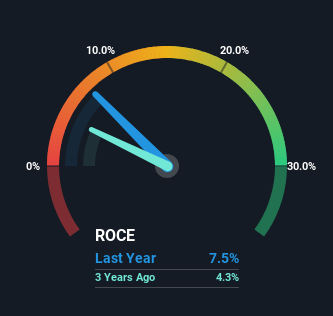DoubleVerify Holdings' (NYSE:DV) Returns On Capital Are Heading Higher
To find a multi-bagger stock, what are the underlying trends we should look for in a business? In a perfect world, we'd like to see a company investing more capital into its business and ideally the returns earned from that capital are also increasing. This shows us that it's a compounding machine, able to continually reinvest its earnings back into the business and generate higher returns. With that in mind, we've noticed some promising trends at DoubleVerify Holdings (NYSE:DV) so let's look a bit deeper.
What Is Return On Capital Employed (ROCE)?
For those who don't know, ROCE is a measure of a company's yearly pre-tax profit (its return), relative to the capital employed in the business. Analysts use this formula to calculate it for DoubleVerify Holdings:
Return on Capital Employed = Earnings Before Interest and Tax (EBIT) ÷ (Total Assets - Current Liabilities)
0.075 = US$87m ÷ (US$1.2b - US$84m) (Based on the trailing twelve months to December 2023).
Therefore, DoubleVerify Holdings has an ROCE of 7.5%. In absolute terms, that's a low return but it's around the Software industry average of 7.3%.
View our latest analysis for DoubleVerify Holdings
Above you can see how the current ROCE for DoubleVerify Holdings compares to its prior returns on capital, but there's only so much you can tell from the past. If you're interested, you can view the analysts predictions in our free analyst report for DoubleVerify Holdings .
How Are Returns Trending?
While in absolute terms it isn't a high ROCE, it's promising to see that it has been moving in the right direction. Over the last five years, returns on capital employed have risen substantially to 7.5%. The amount of capital employed has increased too, by 200%. The increasing returns on a growing amount of capital is common amongst multi-baggers and that's why we're impressed.
What We Can Learn From DoubleVerify Holdings' ROCE
All in all, it's terrific to see that DoubleVerify Holdings is reaping the rewards from prior investments and is growing its capital base. Astute investors may have an opportunity here because the stock has declined 14% in the last three years. With that in mind, we believe the promising trends warrant this stock for further investigation.
Like most companies, DoubleVerify Holdings does come with some risks, and we've found 1 warning sign that you should be aware of.
If you want to search for solid companies with great earnings, check out this free list of companies with good balance sheets and impressive returns on equity.
Have feedback on this article? Concerned about the content? Get in touch with us directly. Alternatively, email editorial-team (at) simplywallst.com.
This article by Simply Wall St is general in nature. We provide commentary based on historical data and analyst forecasts only using an unbiased methodology and our articles are not intended to be financial advice. It does not constitute a recommendation to buy or sell any stock, and does not take account of your objectives, or your financial situation. We aim to bring you long-term focused analysis driven by fundamental data. Note that our analysis may not factor in the latest price-sensitive company announcements or qualitative material. Simply Wall St has no position in any stocks mentioned.

 Yahoo Finance
Yahoo Finance 
